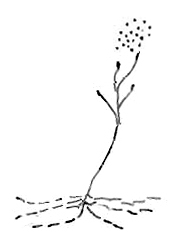Mold is not a plant and not an animal.
Mold is a fungi with its own unique “lifestyle”.
Green plants make their own food using carbon dioxide from air and water through photosynthesis, while simultaneously producing oxygen. This is a great blessing for all living creatures.
1. In contrast to green plants, the food sources for mold are carbon hydrates extracted from the material on which the mold lives. As mold extracts carbon, it destroys the carbon-containing substances: organic materials such as wood, wood-based products and plastics made from petroleum products as well as building materials such as concrete and sheetrock. Additionally, other examples include paper products, card board, paints, insulation, carpets and upholstery. Mold infestations can have catastrophic consequences by weakening or destroying structural elements in buildings. 
2. However, the destruction of materials is not the only concern. While digesting its food, mold releases toxic compounds into the air, which pose a health hazard to humans living in mold -infested houses.
3. Moreover, that is still not all. One mold colony can grow millions of spores to reproduce. As a result, when the tiny spores are airborne and dispersed throughout a building, they are inhaled by the people living in the building causing coughing, allergic reactions or asthma. People have become seriously ill from living in moldy places. The smell alone can be overpowering.
Not all fungi are as unwanted as mold. Some are beneficial decomposers, where decomposition is wanted. For example, when trees die, fungi breaks them down, slowly turning them into earth. In addition, antibiotics such as Penicillin are derived from fungi. Their development has been a blessing for people. Even in our food we welcome the distinctive taste of the yeast-fungi when brewing or baking.

Mold grows as tiny microorganisms on wood, sheet rock and most building materials. The problem begins with a tiny spore, which can wait for years to find the right conditions to grow.
Once the spore develops into fungi, it follows four distict stages:
– First, it penetrates through and under the surface into the substrate, searching for food.
– Next, it develops an ever-extending web that creeps along the surface as long as favorable conditions exists.
– Then, spore-producing extensions grow vertically upwards. The ends swell, and spores are produced.
– Finally, when the spores are ready, they are airborne by the millions and are dispersed into the surrounding air. The slightest draft can carry the spores far away in a short time, where they will, if conditions allow, start growing a new colony.
In summary:
Spores can be found anywhere. Spores need four ingredients to start growing:
- Food (material containing carbons)
- Humidity from water
- Oxygen from the air
- moderate temperatures.
If all these ingredients are abundantly available, spores will grow and start new mold colonies. Since we cannot eliminate the air in buildings nor remove materials containing carbons, nor do we want to live in freezing temperatures, the only solution is to keep the moisture in materials and in the air low enough so prevent mold from developing.
What to do to prevent mold?
To avoid mold growth, the humidity levels should be kept as low as possible day and night, preferably not above 50%. (gov.moldguide). In many cases, that is the only way to control mold growth. When the air stays within these limits, wood, drywall and other materials will also maintain a low enough moisture content.
If exposed to water, building materials will absorb moisture and moisture levels quickly become higher than the mold threshold. Thus, keeping the air humidity low and drying-out materials as quickly as possible, will help prevent mold growth, along with all the undesirable consequences for the health of humans and the health of materials.
→ Thermo-Hygrometers
→ Pin Meters
→ Pinless Meters
https://lignomatusa.com/installing-hardwood-floors-correctly/
Moisture Meters for Building Maintenance


